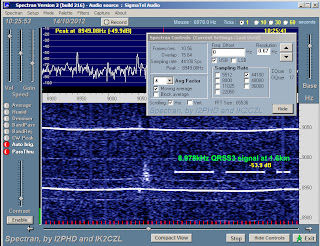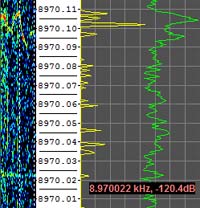My days long, continuous carrier test with
G3WCD (32km) and
G3ZJO (around 50km) around 8.977188kHz ended yesterday. I was using my 20m spaced earth electrodes with 5W out of the PA. The test was to see if anything at all could be detected well beyond the 6km I can repeatably obtain with QRSS3 earth-mode (through the ground) communications. Despite the hint of a signal a couple of times on the G3WCD 45uHz and 22uHz grabbers, these proved to be false signals and nothing was detected.
Using Spectrum Lab, locked to a VLF MSK signal I am able to measure my TX frequency with VERY great accuracy, in fact to an accuracy of less than 1mHz. What this showed up was that my crystal controlled TX drifted (very slightly by HF VFO standards) about 13mHz over the 4 days of the test. Starting frequency was around 8.977177kHz and the final frequency 8.977190kHz. With shack temperature variations it may have moved slightly higher or lower too.
When the RX stations are looking for a very very weak signal in a bandwidth of 22uHz this means the signal is only "within band" for the FFT software to analyse for a brief period before drifting out of the measuring "bucket". To have ANY chance it will be essential for me to lock the TX frequency so that it stays within a few uHz over a period of days. This could be done using a GPS reference signal or using Spectrum Lab. It is the latter that I shall be trying - receiving a VLF MSK signal on one antenna as the reference, then using SL to synthesise the continous TX carrier which is transmitted on a second antenna.
In reality to get 32km on VLF with my set-up was always a "long shot", but all parties agreed it was worth trying and we have all learned a lot in the process. Experimentation is the name of the game and failure is as important as success.
It may be some time before I try the long range VLF tests again: I hope to have over 100W next time and a super-stable TX signal. Who knows, we might just succeed next time.
For information on these software packages (all free) that I use at VLF see
https://sites.google.com/site/sub9khz/software .

















